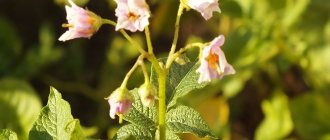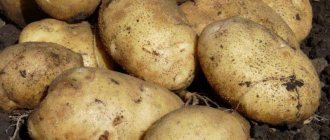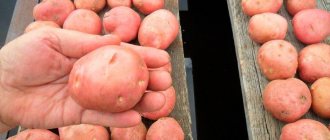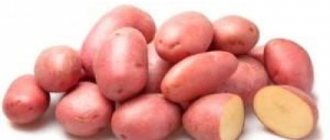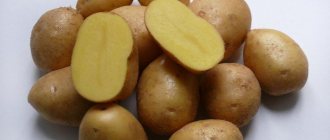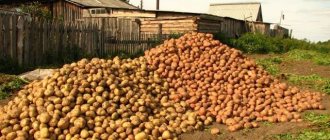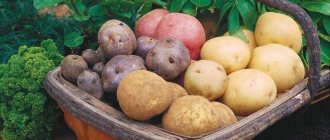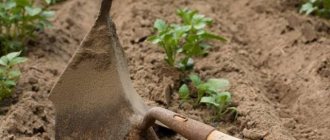Potatoes are a traditional crop for the temperate climate zone. But not all countries in the northern hemisphere have favorable conditions for it; what can be done if the summer is short and there are not so many warm days?
This is where early varieties come to the rescue. In addition, growing young potatoes is not a difficult and exciting activity. You will need a little strength and patience, but, perhaps, the main thing is that you need to know the peculiarities of cultivating early potatoes, and choose a variety that will grow well in your area and give a rich harvest.
Do you like the taste of Adretta potatoes but can't find them anywhere? Don’t be upset, there is a variety very similar to it in taste and commercial qualities, it’s called Nandina. It should be noted that the Nandina variety has long been loved by gardeners. Let's find out what is the secret of his popularity?
Description of the variety
Nandina potatoes are an ultra-early variety bred by breeders of the German company Europlant Pflanzenzucht GmbH. Included in the State Register of Russia in 2015. The crop shows maximum productivity in the Volga-Vyatka, Central, and North Caucasus regions.
The photo shows Nandina potatoes.
The table contains the main characteristics of the variety .
| Indicators | Characteristic |
| Ripening period | 40-45 days subject to prior germination |
| Bush | Medium height, leaf type, semi-erect |
| Number of tubers in a bush | 8-12 |
| Weight | 72-132 g |
| Form | Oval-round with small eyes |
| Coloring | Yellow peel and flesh |
| Leaves | Large, intermediate type, light green and green in color |
| Corolla color | Light purple with a red tint on the inside |
| Starch content | 12-15% |
| Taste | 4 on a five-point scale |
| Cooking class/group | B (medium crumbly) |
| Productivity | The first dig - 82-177 c/ha, the second - 115-238 c/ha, maximum yield - 329 c/ha |
| Marketability | 77-93% |
| Keeping quality | 93% |
| Purpose | Dining room |
| Sustainability | To wrinkle mosaic, leaf curl, crayfish, golden nematode |
| Transportability | High |
Chemical composition of potatoes
The table shows the complex of vitamins and minerals contained in 100 g of raw tubers.
| Name | Content | Norm |
| Beta carotene | 0.001 mg | 5 mg |
| Vitamin B1 | 0.081 mg | 1.5 mg |
| Vitamin B2 | 0.032 mg | 1.8 mg |
| Vitamin B4 | 12.1 mg | 500 mg |
| Vitamin B5 | 0.295 mg | 5 mg |
| Vitamin B6 | 0.298 mg | 2 mg |
| Vitamin B9 | 15 mcg | 400 mcg |
| Vitamin C | 19.7 mg | 90 mg |
| Vitamin E | 0.01 mg | 15 mg |
| Vitamin K | 2 mcg | 120 mcg |
| Vitamin PP | 1.061 mg | 20 mg |
| Potassium | 425 mg | 2500 mg |
| Calcium | 12 mg | 1000 mg |
| Magnesium | 23 mg | 400 mg |
| Sodium | 6 mg | 1300 mg |
| Phosphorus | 57 mg | 800 mg |
| Iron | 0.81 mg | 18 mg |
| Manganese | 0.153 mg | 2 mg |
| Copper | 110 mcg | 1000 mcg |
| Selenium | 0.4 mcg | 55 mcg |
| Zinc | 0.3 mg | 12 mg |
Differences from other varieties
Table of differences from other early potato varieties.
| Name | Tuber weight, g | Starch content, % | Productivity, c/ha |
| Impala | 88–150 | 10,5–14,6 | 180–367 |
| Timo | 65–120 | 13,4–14,2 | 150–303 |
| Luck | 120–150 | 12–15 | 300–500 |
| Molly | 98–142 | 11,4–13,4 | 171–308 |
| Labella | 78–102 | 12–15 | 176–342 |
Early maturing potato varieties
Early ripening potato varieties, according to reference books: Early Belorussian, Impala, Novinka, Rozana, Sedov, Ulyanovsky, Pushkinets.
In the State Register, the following varieties are marked “early ripening”: Ivory Russet, Aksenia, Alena, Almaz, Alova, Antonina, Arosa, Arrow, Artemis, Baron, Bashkirsky, Bellaprima, Bellarosa, Bonus, Bryansky early, Varmas, Vega, White Spring, Vineta , Vitesse, Gloria, Goryanka, Darenka, Dalfin, Europrima, Ermak improved, Zhukovsky early, Zabava, Zorachka, Impala, Inara, Iskra, Kaluzhsky, Kamensky, Karatop, Caruso, Kibits, Kislovodsky, Colette, Queen Anna, Corolle, Beauty, Krasnoyarsk Early, Krepysh, Kristel, Merchant, Labella, Lapis Lazuli, Laperla, Latona, Lady Blanca, Lady Lenora, Lady Olympia, Leonie, League, Leader, Lomonosovsky, Lyubava, Lyudmila, Lux, Madeline, Madingly, Matushka, Miranda, Molly, Mostovsky, Madison, Natasha, Neptune, Newton, Flint, In Memory of Kulakov, In Memory of Osipova, Panther, Penza Early, Povin, Povirovets, Pogarsky, Priobsky, Pushkinets, Reggae, Red Lady, Red Scarlett, Riviera, Rikea, Rosalind, Rosanna, Rosara , Saxon, Salin, Samara, Sarov, Northern, Serpanok, Skoroplodny, Bullfinch, Sprint, Timo Khankkiyan, Tulunsky early, Luck, Uladar, Ural early, Duckling, Early morning, Felox, Figaro, Fidelia, Fioretta, Fresco, Khibiny early, Kholmogorsky, Sheri, El Mundo, Jubilee, Yuna, Yakutian, Yarla.
For the Moscow region and the Middle Belt, the State Register recommends:
As you can see, there are a lot of early-ripening potato varieties. In order not to “clog up the airwaves,” we would recommend going straight to the State Register and reading in more detail the characteristics of all early potato varieties https://reestr.gossort.com/reg/main/126. They are indicated in the table by the number “3”. There are also notes on the recommendation for the use of the variety in a particular region.
Here we will give a description of only some varieties with photos:
Red Scarlett
Tubers: elongated, oval-shaped, small eyes. The tubers are red in color with yellow flesh. Tuber weight: 56-102 g. Resistance: to potato canker, golden nematode, sensitive to late blight on leaves.
Impala
Tubers: oval, yellow skin and pulp, with small eyes. Tuber weight: 88-150 g. Resistance: to cancer and nematode, scab, sensitive to late blight and rhizoctonia.
Queen Anne
Tubers: elongated, oval-shaped, with small eyes, yellow skin and flesh. Tuber weight: 84-137 g. Resistance: to potato cancer, golden nematode, wrinkled banded mosaic and leaf curl.
Labella
Tubers: elongated, oval-shaped, with small eyes. The skin is red and the flesh is yellow. Tuber weight: 78-102 g. Resistance: to potato cancer, golden nematode, leaf curl virus.
Dolphin
Tubers: oval, round, with small eyes. The peel and pulp are yellow. Tuber weight: 80-132 g. Resistance: to potato cancer and golden nematode, to wrinkled, striped mosaic and leaf curl.
For the Moscow region and the Middle Belt, the State Register recommends:
Impala, Rosanna, Pushkinets, Ivory Russet, Alova, Arrow, Artemis, Bellaprima, Bonus, Bryansk early, Vega, Vineta, Dalfin, Europrima, Zhukovsky early, Fun, Zorachka, Inara, Iskra, Kaluzhsky, Kibitz, Colette, Queen Anna, Corolle, Beauty, Kristel, Merchant, Labella, Lapis Lazuli, Latona, Lady Blanca, Lady Lenora, Lady Olympia, League, Lux, Madingly, Molly, Neptune, Newton, In Memory of Kulakov, Panther, Povin, Pogarsky, Red Lady, Red Scarlett, Riviera, Rikea, Rosalind, Saxon, Salin, Serpanok, Skoroplodny, Bullfinch, Timo Hankkiyan, Luck, Uladar, Felox, Fidelia, Fioretta, Sheri, El Mundo, Yarla.
(specifically for the Central region according to the State Register).
For the Urals and Siberia:
Pushkinets, Alena, Antonina, Arosa, Baron, Bellarosa, Varmas, White Spring, Vineta, Eramk improved, Zhukovsky early, Kamensky, Karatop, Krasnoyarsk early, Leader, Lyubava, Lux, Madeline, Priobsky, Pushkinets, Red Scarlett, Rosalind, Rosara , Sarovsky, Northern, Skoroplodny, Tulunsky early, Luck, Early morning, Felox, Fresco, Jubilee, Yuna, Yakutian.
Features of planting and growing
variety is easy to care for . To grow the crop, standard agrotechnical techniques are used: watering as needed, hilling bushes, weeding, loosening the top layer of soil, fertilizing with minerals.
Preparing tubers for planting
To obtain an early harvest and the opportunity to make three harvests , selected tubers are pre-germinated. The seed material is taken out of the cellar into sunlight, re-sorted, rotten specimens are discarded, washed with running water, dried and soaked in a disinfecting solution. For this, copper sulfate, potassium permanganate, “Prestige”, “Fitosporin-M” are used. Then the tubers are placed in boxes with holes and wait for the seedlings to appear. The optimal room temperature is +14…+16°C.
Before planting in the ground, the seeds are treated with growth stimulants "Epin-Extra", "Zircon", "Albit", "Immunocytophyte" and re-sorted.
Soil preparation
Nandina grows best on gray light forest soils, peat bogs, and sandy loams . Chernozem and heavy soil for this variety are not the best option.
In the fall, digging, harrowing and loosening of the soil are carried out. To increase fertility, the area is fertilized with manure at the rate of 5 kg per square meter. m, they sow flax, lupine, rye, oats, and wheat. After 30 days, the mowing of these green manures is buried in the soil to enrich the soil with nitrogen and prevent the development of pathogenic microflora.
Dates, scheme and rules of planting
The ideal soil temperature for planting potatoes is +8…+10°C. The lunar calendar is used to calculate time :
- in the North Caucasus region, potatoes are planted in April;
- in Central - in early May;
- in Volgo-Vyatsky - from May 10 to May 15.
Planting scheme:
- depth - 8-12 cm;
- the gap between the holes is 30-35 cm;
- Row spacing is 70-90 cm.
200 g of wood ash and 25 g of nitrophoska are placed in each hole.
Rules of care:
- Watering. With normal rainfall, Nandina does not need regular watering. However, during drought, the bushes are watered once every 10 days. For hand irrigation, water after sunset to prevent sunburn on the leaves. When using a drip irrigation system, the soil is moistened at any time.
- Loosening the soil. This procedure prevents the formation of a dense earthen crust and ensures free access of oxygen to the root system and tubers.
- Weeding. Weed removal is carried out as the plants grow, preventing rooting.
- Hilling is carried out twice: after the shoots reach 10-15 cm in height and during the flowering period. This helps strengthen the rhizome, protects against night frosts, and stimulates tuber formation.
- Feeding. The variety does not require additional organic fertilizer during growth. Manure and ash introduced in the fall during planting are quite sufficient for the harmonious growth of tops and tubers. An excess of nitrogen provokes the growth of green mass and the shrinkage of tubers. If the tops turn yellow and dry, the bushes are additionally sprayed with a mineral solution a month before harvesting: 35 g of ammonium nitrate, 20 g of superphosphate per 10 liters of water.
- Mulching. This is a mandatory procedure, however, covering the beds with straw or hay will retain moisture in the soil and stop the growth of weeds.
Diseases and pests
According to the originator, the Nandina variety is susceptible to late blight of tops and tubers . The disease is caused by the late blight fungus, a lower mycelial organism that parasitizes plant tissues.
Signs of the disease:
- brown spots on the lower leaves;
- white coating on the back of the sheet;
- longitudinal brown stripes on stems;
- depressed brown spots with a gray tint on tubers;
- rusty necrotic lesions of the pulp;
- dry or wet rot on tubers.
How to properly care for the variety
Lugovskoy potatoes are not demanding in terms of care, but there are general rules.
Features of watering
In the southern regions, plantings need additional watering: Lugovskoy potatoes are sensitive to severe, prolonged droughts. Usually it is enough to shed 3 times per season:
- when sprouts appear;
- during the budding period;
- after flowering.
It is preferable to use drip irrigation. If this is not possible, then the soil is moistened manually to a depth of 0.5 m.
Feeding and fertilizing
If for some reason the soil was not fertilized in the fall or the soil composition is very poor, then additional nitrogen fertilizing is applied during the period when active growth of shoots begins. Granules are scattered over the soil surface immediately before watering or precipitation. When water gets on them, fertilizers dissolve and penetrate into the soil.
During the season, superphosphate is used according to the instructions on the package. With its help, the root system becomes stronger, productivity increases, the plant's immunity is strengthened, and the growth and maturation of tubers is accelerated.
Potassium sulfate is also beneficial for potatoes. This fertilizer promotes resistance to unfavorable climatic conditions, increases the supply of starch in tubers, and improves the keeping quality of potatoes.
Supporters of natural fertilizers, to obtain the necessary microelements, add mullein infusion or chicken droppings and birch ash during the season. Straw is used not only as fertilizer, but also for mulch.
Hilling and weeding
During the growth process, Lugovskaya potatoes are weeded and hilled.
Usually weeding is combined with hilling. However, if the tubers were planted without germination, then the weeds will begin to grow before the potato shoots appear
Then the plantings are weeded by hand or carefully passed with a flat cutter.
Hilled potato bushes
In the southern regions, the soil is not raked under the bushes, as a large amount of water evaporates. In these areas the soil is simply loosened. In areas with a cooler climate, hilling is carried out 2 times per season.
As a result of hilling potatoes:
- more tubers are formed;
- the soil supports the shoots better;
- soil aeration occurs;
- weeds are cut down.
During the flowering period and further, until harvesting, planting does not require care.
Collection, application and storage of crops
Rules for harvesting ultra-early potatoes:
- The first digging is carried out 35–40 days after full germination, the last - at the end of August.
- A week before harvesting, the tops are cut and removed from the site. During this period, the peel becomes dense, which allows you to store the crop longer.
- After digging, the tubers are left to “rest” for 1–2 weeks in a dry, dark place, then sorted and stored in the cellar. The seed material is left in the sun for landscaping.
- The storage and containers are washed and dried. Tubers are placed in ventilated containers: plastic or wooden boxes, nets, burlap. The optimal storage temperature is +3...+4°C, humidity is 70-80%.
Reference. After harvesting, complex biochemical processes occur in the tubers, accompanied by the removal of excess moisture, compaction of the outer shell, and healing of damage.
The moderate starch content in Nandina potatoes allows it to be used for frying, boiling, baking, and stewing. The pulp does not darken after cooking and cutting raw. The variety is grown primarily for young potatoes.
Features of cultivation and possible difficulties
variety is characterized by increased sensitivity to cold . Air temperatures below -4°C lead to the withering of the tops and the death of tubers. Ice crystals form in potatoes, destroying the cells. Frozen tubers begin to rot. For this reason, potatoes are planted after the threat of overnight frost has passed. To be on the safe side, in the first two weeks the beds are covered with black agrofibre.
Tips and reviews
Reviews about the Nandina variety are mostly positive . The crop is valued for its early ripening, the ability to make 2-3 digs, and ease of care.
Vera, Zavolzhye : “When planting early varieties of potatoes, I focus on the soil temperature. If the soil has warmed up to +10°C, you can safely plant tubers. Nandina is one of those varieties that is afraid of night frosts, so to be on the safe side, I cover the beds with film, and remove them after stable warm weather sets in. I like this potato for its low maintenance requirements. I fertilize the site in the fall with humus, and in the spring with wood ash. As my experience shows, this is enough to gain green mass and form tubers.”
Dmitry, Pyatigorsk : “I grow the Nandina potato variety to get an early harvest. Its productivity is high and its taste is excellent. I noticed that potatoes become the most delicious closer to August. I use chicken manure as a fertilizer, fill it with water for a day, then add ash. I mix and dilute with water in a ratio of 1:10. I water the area with this mixture before planting. During the flowering period, I water it once and feed it with nitrophoska. The tubers are formed large, in large quantities.”
Nandina potato variety
Potatoes are a traditional crop for the temperate climate zone. But not all countries in the northern hemisphere have favorable conditions for it; what can be done if the summer is short and there are not so many warm days?
This is where early varieties come to the rescue. In addition, growing young potatoes is not a difficult and exciting activity. You will need a little strength and patience, but, perhaps, the main thing is that you need to know the peculiarities of cultivating early potatoes, and choose a variety that will grow well in your area and give a rich harvest.
Do you like the taste of Adretta potatoes but can't find them anywhere? Don’t be upset, there is a variety very similar to it in taste and commercial qualities, it’s called Nandina. It should be noted that the Nandina variety has long been loved by gardeners. Let's find out what is the secret of his popularity?
Description, characteristics
This variety ripens very early, its tops grow surprisingly intensively and tuber formation begins early. Nandina is one of the ultra-early varieties, but it is not the only one; Early Rose, Alena, Iskra, Meteor can boast of the same properties; they are popularly called “magpies”. This name was not given by chance, because already 40-45 days after planting you can begin to dig up the first harvest. But, if you are going to remove the potatoes for storage, then there is no need to rush into it. Have you enjoyed new potatoes? Great. Then wait 2-3 weeks, dig again, check, if the skin has become strong, you can start harvesting.
The height of the bush is average, the plant is semi-erect. Nandina's tubers have an attractive shape, they are oval, with small eyes. The yellow pulp has an excellent taste and delicate aroma; after heat treatment, the color of the potato does not change. The peel is also yellow, smooth, and easy to peel.
Thanks to the nutrients contained in the tubers, Nandina has long gained a reputation as not only tasty, but also healthy potatoes.
This variety has strong immunity to various kinds of diseases, it finds the strength to resist cancer, scab and other dangerous diseases.
Another important advantage is good keeping quality, which is not typical for most early varieties. But here you need to take into account that only fully ripened tubers can be stored well. What do you need to know in order to grow it on your site?
Nandina potato variety
Potatoes are a traditional crop for the temperate climate zone.
But not all countries in the northern hemisphere have favorable conditions for it; what can be done if the summer is short and there are not so many warm days? This is where early varieties come to the rescue. In addition, growing young potatoes is not a difficult and exciting activity. You will need a little strength and patience, but, perhaps, the main thing is that you need to know the peculiarities of cultivating early potatoes, and choose a variety that will grow well in your area and give a rich harvest.
Do you like the taste of Adretta potatoes but can't find them anywhere? Don’t be upset, there is a variety very similar to it in taste and commercial qualities, it’s called Nandina. It should be noted that the Nandina variety has long been loved by gardeners. Let's find out what is the secret of his popularity?
Planting and care
Nandina is planted with germinated tubers or seedlings. This shortens the period of acclimatization and fruit ripening.
The tubers that you choose for planting should weigh 50-80 g, and there should not be any small, diseased, lethargic, softened or deformed tubers among them.
After the planting material has been selected (some gardeners advise doing this even during harvest, from the “richest” bushes), you can begin to disinfect the tubers; they can be treated with growth stimulants and mineral fertilizers.
After this, the potatoes are poured into boxes in one or two layers and left to germinate in a dry, bright room at a temperature not lower than +12 and not higher than 15 C, closer to the light source. It is left for 25-30 days, but this does not mean that you can forget about it. Carefully turn the potatoes on one side or the other towards the light so that the sprouts on their surface are uniform.
The site for planting must be prepared in the fall. The ground should be dug up; wood ash, rotted manure or compost can be added here. You can also add fresh manure; it will rot over the winter. But in the spring, manure cannot be applied in this form; the plants may “burn.” The main condition for obtaining a good harvest is that the soil must be loose and nutritious. The size of the tubers, their shape and even their taste depend on the air capacity of the soil and its density.
If you are a beginner and are starting to plant for the first time, then you need to take into account that all early potato varieties, including Nandina, are best planted on gray forest soils, sandy loams or drained peat bogs.
Tubers with sprouts of 2-3 cm can be planted. Rotten ones, with only one shoot, or sprouts resembling thin threads cannot be planted. Planting Nandina is carried out in the same way as planting potatoes of other varieties; everything must be done carefully, because tubers with broken sprouts may not yield a harvest.
The best time for this is the beginning of May, when the threat of frost has already passed. The planting depth is about 20 cm, but if the soils are dry, make the hole deeper. You can pour a handful of ash or a little onion peel into the bottom of the hole. The main thing is not to overdo it, because an excess of fertilizers has the same negative effect on the growth of tubers as their lack.
When all the sprouts emerge from the ground, you can water the potatoes for the first time. The second watering is carried out when the development of the stems begins. The third watering is necessary for potatoes when the plant begins to bud; this is a period of intensive growth of tops and the formation of starch in the tubers. At this time, potatoes especially need watering and additional nutrients, otherwise the growth of tubers may stop.
Nandina care
Temperature and lighting - Nandina needs long daylight hours. Protection from direct rays of the sun is needed. The rich red color of the leaves can only be obtained in good lighting. In addition, with a lack of light, the plant begins to hurt.
In summer it will grow at room temperature, but prefers temperatures around 20 degrees. Wintering needs to be cool, no higher than 12 degrees, preferably 8-10. If you cannot provide a cool winter, it is better to avoid growing nandina.
Air humidity and watering - nandina is quite drought-resistant; the top layer of soil should dry out between waterings. The higher the temperature, the more it is watered . In winter, they only make sure that the earthen lump does not dry out completely.
Increased air humidity is needed; spray twice a day and only with soft water. In winter they do not moisturize.
Fertilizer and fertilizing - from spring to autumn twice a month, alternating organic and mineral fertilizing.
Soil and replanting - young nandinas annually, and adults - once every 2-3 years in a larger pot, without deepening the root collar. You need humus-rich soil and good drainage.
Flowering and pruning - in potted culture it usually blooms in late spring, some varieties do not bloom. Requires regular pruning and can be shaped as a bonsai.
Grape diseases and their control: means for treatment and prevention
Nandina inflorescences
Nandina looks good in a pot alone, in a group or as a bonasi.
Important!
- Do not cut or scratch sprouts and roots; they do not recover after injury.
- During the formation of buds, the bushes need to be hilled.
- It is recommended to treat plants to prevent late blight.
- Many gardeners advise adding ash or urea to the soil; it is generally accepted that such soil is not the best environment for the Colorado potato beetle and its larvae.
During the first watering, potatoes can be fed with urea (1 tbsp per 10 liters of water). As you can see, care is very simple, another advantage is that you don’t have to fight the Colorado potato beetle, treat plants with pesticides and chemicals, annoying insects simply won’t have time to harm you.
Nandina potatoes ripen very early. This variety is a variety of table potato. The growing season of the variety takes 40-45 days, provided that germinated potatoes are planted. Therefore, potatoes can be classified as an early crop based on the speed of ripening. Choosing this variety is an ideal decision to start the season. The crop belongs to varieties with a reduced nitrogen requirement, so fertilizers do not have a decisive effect on the growth of tubers.
Diseases and pests of nandina
Scale insects brown plaques appear on the shoots and leaves of nandina. The leaves turn yellow and fall off. Control measures: remove scale insects with a soft cloth soaked in soapy water. In case of severe infection, treat the plant with actellik (15-20 drops per 1 liter of water) or decis.
Spider mite nandina leaves turn yellow, a thin silvery cobweb appears on the underside of the leaves Control measures: remove the affected leaves, spray the plant with water. In case of severe infection, treat the plant with decis or acteplic.
Aphids settle on the undersides of leaves, causing them to discolor and curl. A sooty fungus settles on the secretions of aphids. Control measures: treat the plant with a soap solution. In case of severe infection, treat nandina with actellik or fufanon.
| ROOM FLOWERS |
Characteristics of the variety
Frost resistance
Potato Nadina is a plant sensitive to cold. Frosts below -4 Celsius can damage the tops and kill the tubers. During frosts below zero, ice crystals form in the tubers, which destroy the cells. Frozen potatoes will soon begin to rot. Therefore, it is important to plant Nandina after the frost has passed.
Productivity
The yield of the variety is very high - from one hundred square meters you can get up to 330 kilograms of potatoes. Product characteristics – 77-93%. Keeping quality parameters – 93%.
Bloom
The buds of Nandina potatoes correspond to the following description: light red-violet, large. The corolla reaches medium size at the time of flowering. The period of blossoming of buds begins closer to mid-May.
Plant size
The plant reaches medium height, with large leaves on strong tops. The weight of a varietal tuber can reach 70-130 grams, depending on the intensity of watering and the time of harvest.
History of variety development
The Timo variety was bred in Finland, the originator is Boreal Plant Breeding LTD. Considering that Finland is a northern country, the growing season of plants there is quite short, but warm and sunny summers make it possible to grow high-quality potatoes.
So that potatoes have time to grow and ripen in a short period of time, breeders are actively creating ultra-early varieties, one of which is Timo. Thanks to its early ripening, the variety can be successfully grown throughout Central Russia.
Experts advise choosing the Northern, Central and Northwestern regions for cultivating Timo potatoes.
Agrotechnics of cultivation
Soil for tubers
Important! Gray forest soils, peat bogs or sandy loams are recommended for the variety. Germination under film will allow you to achieve an earlier harvest. This is a feature of the variety. To do this, you need to germinate the seeds in advance.
Potatoes under film
Some gardeners use ash and urea to combat the Colorado potato beetle. These substances are added to the soil before planting potatoes. Urea should be diluted in a proportion of 1 tablespoon per 10 liters of water. However, late blight poses a much greater threat to Nandina.
The plot of land must be prepared in the fall. Loose and nutritious soil is the key to a large harvest.
Landing feature
Large tubers with evenly sprouted eyes are selected for planting. By weight, planting material should be approximately 50-80 grams. Before planting, it must be poured into boxes and placed in a dry, well-lit room. It is necessary to periodically rotate the boxes so that the sprouts are distributed evenly throughout the potatoes. Such tubers will give a good harvest with careful care.
Boarding time
Planting time is May. It is best to plant at the beginning of the month. However, if it is still frosty outside, then planting can be done at the end of May. It is better to plant Nandina with sprouted tubers or seedlings to a depth of 20 centimeters. If the soil is dry, you can plant the plant deeper.
Note! A special feature of planting is that rapid acclimatization of the crop and accelerated growth of tops are possible if the crop is planted with tubers. Varietal potatoes can be treated with mineral fertilizers. Planting material should not be lethargic, rotten or damaged. Such potatoes will not produce a rich harvest.
Planting must be done at a distance of 30-40 cm between tubers. This is an important condition for full ripening, since a large number of tubers are formed in one nest. Between the rows you need to maintain a distance of 70-80 centimeters.
Chemical treatment of potatoes
For a rich harvest, it is recommended to spray the crop against late blight. Regular desiccation will help increase the strength of the peel. This is necessary in order to harvest the crop on time and dig up large potato tubers. Desiccation occurs as follows: the tops are sprayed with chemicals, the leaves begin to dry out, and all the nutrients go into the roots, that is, into the potatoes. In this way, the growth of tubers is stimulated, and the potato composition is saturated with essential minerals. This procedure must be carried out before harvesting.
Watering
Note! Potato sprouts are tender; if the roots of the plant are damaged, the growth of the crop will stop. Therefore, it is important not to harm the sprouts during watering.
Only after sprouts appear from the planted tubers can the first watering be done. When stems have already developed from the sprouts, a second irrigation can be done. The appearance of buds is a sign to the gardener to water the crop for the third time. During this period, the plant begins to bloom and the tops are fully formed. It is extremely important to water Nandina during this period, as this is the main growth stage of the crop. It is at this time that starch is formed in the tubers.
At the moment of flowering of potatoes, the tops must be covered from below with moist soil. After the potatoes have been hilled, new potato ovaries form inside the filled mound. For this, the gardener will need a hoe. It is better to hill up the tops before or after noon.
Advantages and disadvantages of the variety
Advantages
- Potatoes ripen in 40-45 days, which means that the harvest from Nandina can be harvested three to four times per season;
- The Nandina variety is resistant to diseases such as canker, potato golden nematode, wrinkled band mosaic and leaf curl;
- Nandina is an early variety; you can enjoy young potatoes already in mid-summer;
- Potatoes have high yields and do not require special care;
- The peel and pulp do not darken after cooking. The color remains golden-yellowish;
- Good shelf life. This is excellent quality for table potatoes. A gardener stocking up for the winter will find Nandina an ideal variety for the pantry.
Flaws
- The crop is susceptible to late blight. However, disease and death of tubers can be avoided by spraying the plants with chemicals in a timely manner;
- Nandina, unlike Red Fantasy, Roxanne and Razlind, is not suitable for trade, since it does not have such high culinary properties. Other varieties are much more pleasant in taste, but also require a more complex approach to agricultural technology;
- The keeping quality indicator applies only to fully ripened tubers. Root crops that are just germinating must be treated with caution and stored in a dry place until planting.
Planting Nandina potatoes is an ideal solution for gardeners planning to harvest three to four crops per season. The tubers are large, with a rich taste and high starch content. These are the characteristic features of the variety. It is worth remembering that early varieties require special care. Proper and timely watering can provide a gardener with a harvest of up to 330 kilograms per acre. However, the variety does not require tireless care; unlike other crops, it is unpretentious to soil and moisture.
Varietal characteristics of Nandina potatoes
The State Register documents set out the characteristics of Nandina potatoes and a description of the variety. It is emphasized that the varietal original Nandina potato bushes have medium height stems and have large leaves of light green and green shades. During fruit formation, medium and large flowers with a weak anthocyanin color appear from the buds at the tops of the stems. The first harvest of root crops is obtained 45 days after emergence.
Potato tubers
Tubers of any type of potato are not the fruit of potato bushes. They develop at the ends of root processes and are modified shortened underground shoots of a spherical or elongated shape. Root crops have axillary buds, called ocelli, which contain reserves of nutrients necessary for the plant to build up vegetative mass and generative organs - flower stalks.
Commercial potato tubers of the Nandina variety have yellow skin and pulp, weigh between 72-132 g, and contain up to 15% starch. The shape of the root crops is oval-round, they have shallow eyes. In places where the Nandina variety is cultivated, Asterix and potatoes are grown - the characteristics of its bushes coincide with the description of the surface parts of the Nandina variety.
Plant tubers have completely different characteristics in terms of external characteristics, yield, marketable weight, taste, chemical composition, and ripening time. According to reviews and descriptions of potato growers, the Asterix variety of potatoes has smaller underground fruits (up to 109 g) and a dense, rough, red skin. The only thing that the two types of potatoes have in common is the yellow color of the tuber pulp when cut.
Important! The Asterix variety has been grown in Russia since 1998, the Nandina variety since 2015.
Taste qualities and chemical composition of the Nandina variety
The basic potato varieties that were used to develop the Nandina potato were grown as fodder root crops in Germany. After breeding work, yellow-fruited potato varieties acquired the qualities of table varieties. In the process of confirming varietal characteristics during tasting tests, the taste qualities of Nandina potatoes received ratings from medium to high. That is, the product was not classified as a delicacy, but its suitability for cooking was confirmed.
Characteristics and description of the Krasavchik potato variety, cultivation and care
Nandina tubers have lower carbohydrate levels than average for potatoes. This indicates that the vegetable will be well boiled, it can be used fried, for making soups and purees. The pulp of the tubers contains a large amount of vitamins, micro- and macroelements, and acids. The human body needs all of them to maintain normal functioning of the cardiovascular system, liver, and gastrointestinal tract.
Note! Excessive consumption of potatoes is harmful for diabetics and overweight people.

